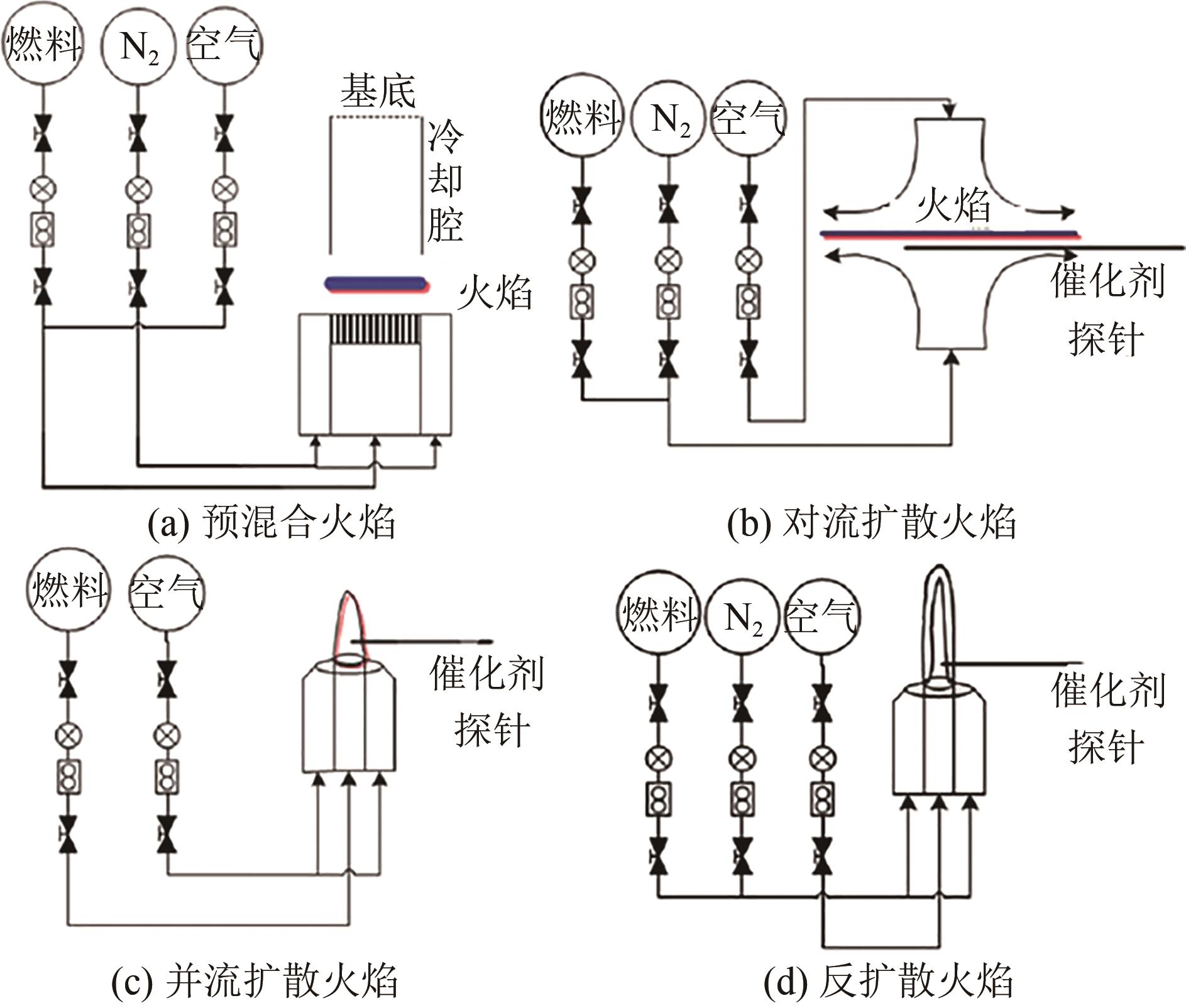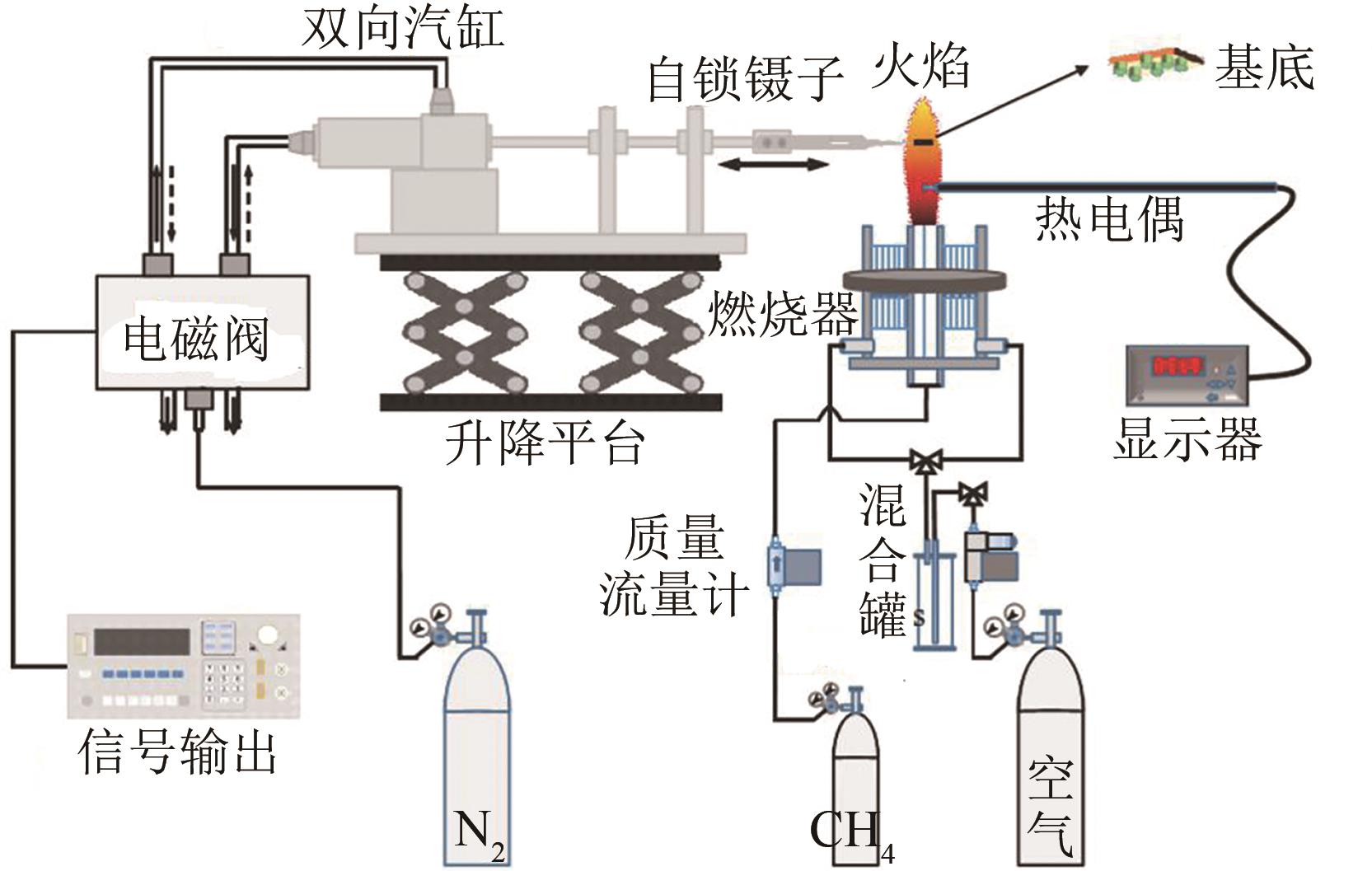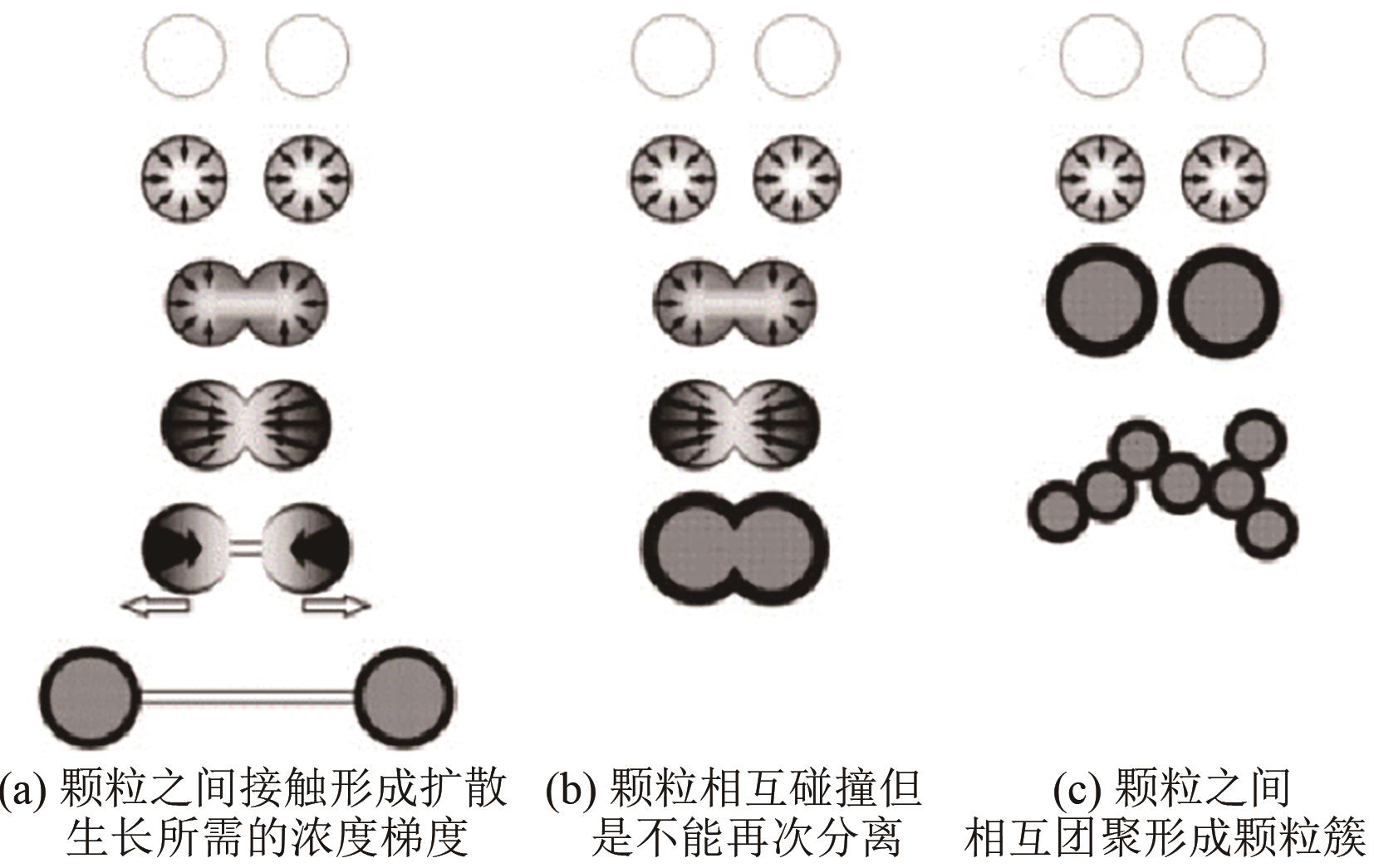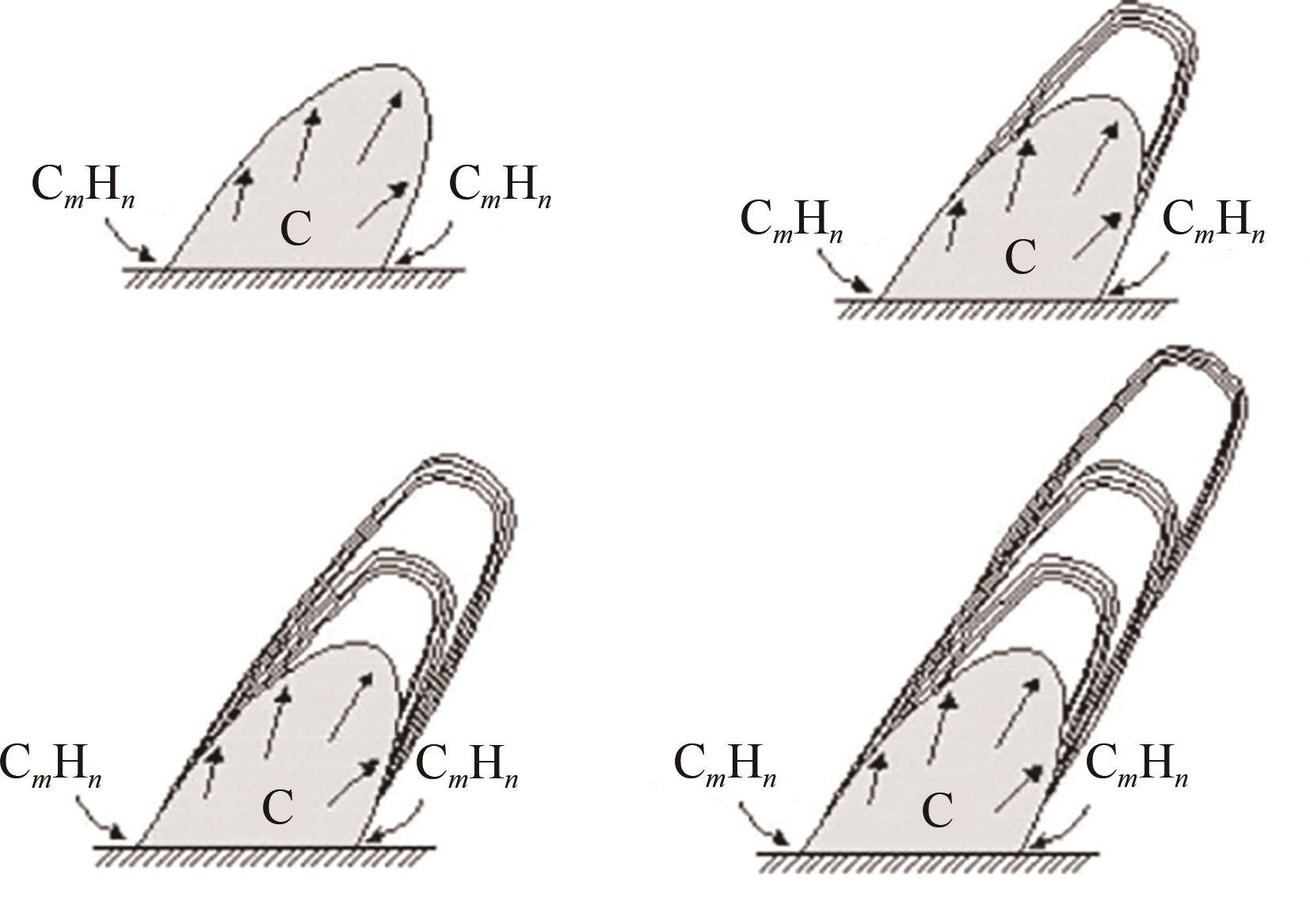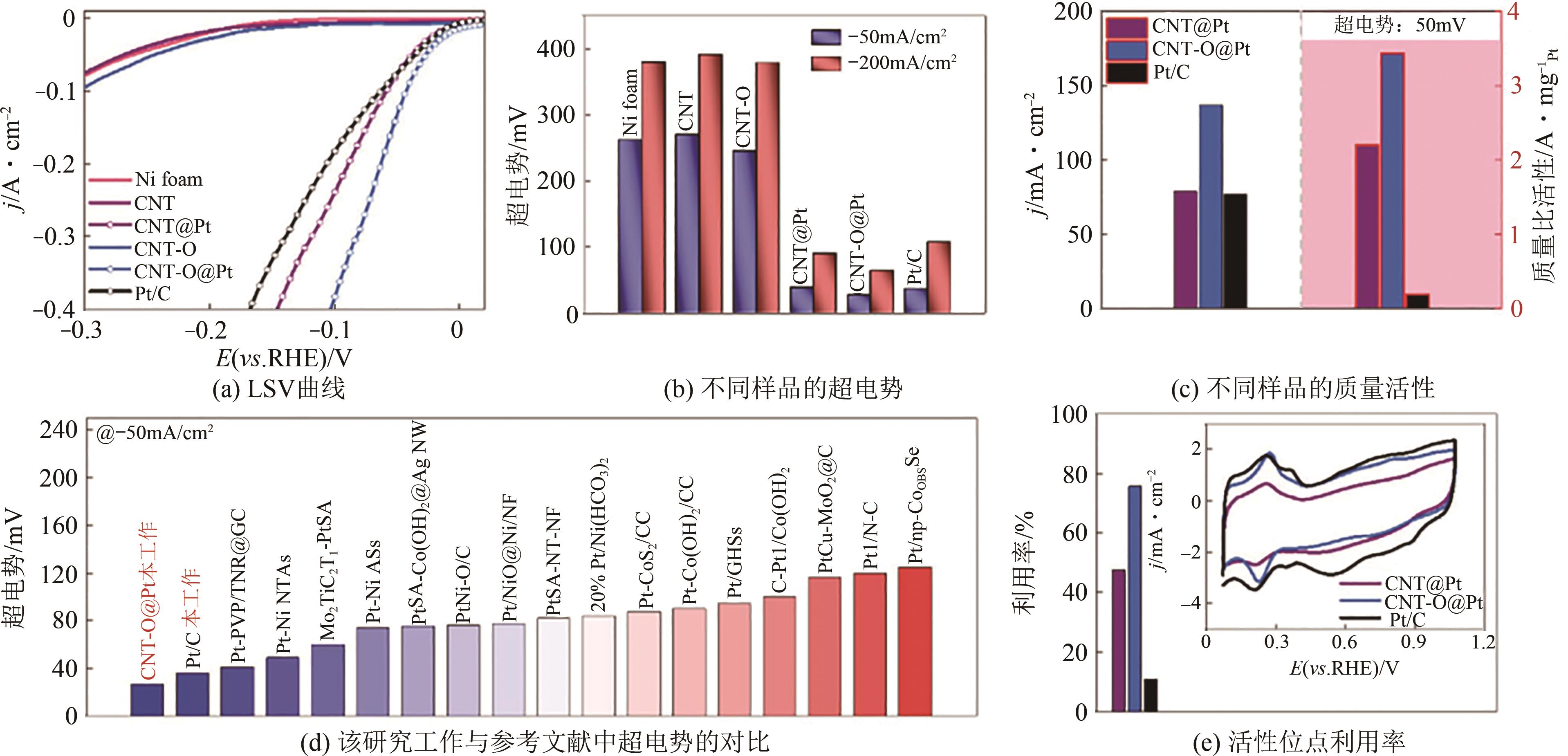Chemical Industry and Engineering Progress ›› 2023, Vol. 42 ›› Issue (12): 6409-6418.DOI: 10.16085/j.issn.1000-6613.2023-0162
• Materials science and technology • Previous Articles
Progress of flame synthesis of carbon nanotubes based composites and their practical applications
ZHANG Shuaiguo1( ), MA Wenyuan1, ZHAO Haipeng1, FENG Yu2(
), MA Wenyuan1, ZHAO Haipeng1, FENG Yu2( ), CAI Xuping1, YANG Shixiang1, QIAN Xinyue1, MI Jie2
), CAI Xuping1, YANG Shixiang1, QIAN Xinyue1, MI Jie2
- 1.College of Material and Chemical Engineering, Henan University of Urban Construction, Pingdingshan 467000, Henan, China
2.Key Laboratory of Coal Science and Technology of Ministry of Education and Shanxi Province, Taiyuan University of Technology, Taiyuan 030002, Shanxi, China
-
Received:2023-02-08Revised:2023-03-26Online:2024-01-08Published:2023-12-25 -
Contact:ZHANG Shuaiguo, FENG Yu
火焰法制备CNTs基复合材料及其应用研究进展
张帅国1( ), 马文媛1, 赵海鹏1, 冯宇2(
), 马文媛1, 赵海鹏1, 冯宇2( ), 蔡旭萍1, 杨士祥1, 钱新月1, 米杰2
), 蔡旭萍1, 杨士祥1, 钱新月1, 米杰2
- 1.河南城建学院材料与化工学院,河南 平顶山 467000
2.太原理工大学省部共建煤基能源清洁高效利用 国家重点实验室,山西 太原 030002
-
通讯作者:张帅国,冯宇 -
作者简介:张帅国(1989—),男,博士,讲师,研究方向为碳纳米材料、锂/钠离子电池电极材料。E-mail:zhangguoyuan.1234@163.com。 -
基金资助:河南省科技攻关计划(232102231031);河南省高校大学生创新创业训练计划(202211765029)
CLC Number:
Cite this article
ZHANG Shuaiguo, MA Wenyuan, ZHAO Haipeng, FENG Yu, CAI Xuping, YANG Shixiang, QIAN Xinyue, MI Jie. Progress of flame synthesis of carbon nanotubes based composites and their practical applications[J]. Chemical Industry and Engineering Progress, 2023, 42(12): 6409-6418.
张帅国, 马文媛, 赵海鹏, 冯宇, 蔡旭萍, 杨士祥, 钱新月, 米杰. 火焰法制备CNTs基复合材料及其应用研究进展[J]. 化工进展, 2023, 42(12): 6409-6418.
share this article
Add to citation manager EndNote|Ris|BibTeX
URL: https://hgjz.cip.com.cn/EN/10.16085/j.issn.1000-6613.2023-0162
| 火焰构型 | 燃料/氧化剂 | 催化剂/基底 | 结构/组成 | 应用 | 参考文献 |
|---|---|---|---|---|---|
| 扩散火焰 | 乙醇/空气 | NiSO4·6H2O/钛箔 | 螺旋碳纳米纤维/CuO/NiO | 超级电容器电极 | [ |
| 扩散火焰 | 乙醇/空气 | 304不锈钢 | CNFs/Fe2O3 | 超级电容器电极 | [ |
| 预混合火焰 | 乙醇/氧气 | 二茂铁 | C@Fe2O3/SWCNT | 锂离子电池负极 | [ |
| 扩散火焰 | 乙醇/空气 | Fe(acac)3/碳布 | M-FeO-CNT | 超级电容器电极 | [ |
| 扩散火焰 | 乙醇/空气 | Ni(NO3)2/304不锈钢 | CNTs | 钠离子电池负极 | [ |
| 扩散火焰 | 乙醇/空气 | Ni(NO3)2/硫脲/镍箔 | CNTs | 染料敏化太阳能电池电极 | [ |
| 扩散火焰 | 乙醇/空气 | NiCl2/CNTs | CNTs | 锂离子电池负极 | [ |
| 扩散火焰 | 乙醇/丙酮/空气 | 玻璃 | 碳微球 | 电催化(ORR) | [ |
| 扩散火焰 | 乙醇/空气 | 泡沫镍 | CNT-O@M(M=Co和Pt) | 电催化(ORR和HER) | [ |
| 扩散火焰 | 乙醇/空气 | 二茂铁/玻璃 | MWCNTs-Fe2O3 | 电化学传感器 | [ |
| 扩散火焰 | 乙醇/空气 | NiCl2/碳纤维 | CNTs | 热电功能材料 | [ |
| 扩散火焰 | 乙醇/空气 | Fe(acac)3/泡沫镍 | Fe2O3/CNT/NF | 光-热功能材料 | [ |
| 扩散火焰 | 乙醇/空气 | NiCl2/玻璃纤维 | CNTs | 结构材料 | [ |
| 扩散火焰 | 乙醇/空气 | 泡沫镍 | CNTs-NF | 钠离子电池负极 | [ |
| 火焰构型 | 燃料/氧化剂 | 催化剂/基底 | 结构/组成 | 应用 | 参考文献 |
|---|---|---|---|---|---|
| 扩散火焰 | 乙醇/空气 | NiSO4·6H2O/钛箔 | 螺旋碳纳米纤维/CuO/NiO | 超级电容器电极 | [ |
| 扩散火焰 | 乙醇/空气 | 304不锈钢 | CNFs/Fe2O3 | 超级电容器电极 | [ |
| 预混合火焰 | 乙醇/氧气 | 二茂铁 | C@Fe2O3/SWCNT | 锂离子电池负极 | [ |
| 扩散火焰 | 乙醇/空气 | Fe(acac)3/碳布 | M-FeO-CNT | 超级电容器电极 | [ |
| 扩散火焰 | 乙醇/空气 | Ni(NO3)2/304不锈钢 | CNTs | 钠离子电池负极 | [ |
| 扩散火焰 | 乙醇/空气 | Ni(NO3)2/硫脲/镍箔 | CNTs | 染料敏化太阳能电池电极 | [ |
| 扩散火焰 | 乙醇/空气 | NiCl2/CNTs | CNTs | 锂离子电池负极 | [ |
| 扩散火焰 | 乙醇/丙酮/空气 | 玻璃 | 碳微球 | 电催化(ORR) | [ |
| 扩散火焰 | 乙醇/空气 | 泡沫镍 | CNT-O@M(M=Co和Pt) | 电催化(ORR和HER) | [ |
| 扩散火焰 | 乙醇/空气 | 二茂铁/玻璃 | MWCNTs-Fe2O3 | 电化学传感器 | [ |
| 扩散火焰 | 乙醇/空气 | NiCl2/碳纤维 | CNTs | 热电功能材料 | [ |
| 扩散火焰 | 乙醇/空气 | Fe(acac)3/泡沫镍 | Fe2O3/CNT/NF | 光-热功能材料 | [ |
| 扩散火焰 | 乙醇/空气 | NiCl2/玻璃纤维 | CNTs | 结构材料 | [ |
| 扩散火焰 | 乙醇/空气 | 泡沫镍 | CNTs-NF | 钠离子电池负极 | [ |
| 1 | SANCHEZ-VALENCIA J R, DIENEL T, GRÖNING O, et al. Controlled synthesis of single-chirality carbon nanotubes[J]. Nature, 2014, 512(7512): 61-64. |
| 2 | CASAS C, LI W Z. A review of application of carbon nanotubes for lithium ion battery anode material[J]. Journal of Power Sources, 2012, 208: 74-85. |
| 3 | MISHRA Vijay, SINGH Manvendra, NAYAK Pallavi, et al. Carbon nanotubes as emerging nanocarriers in drug delivery: An overview[J]. International Journal of Pharmaceutical Quality Assurance, 2020, 11(3): 373-378. |
| 4 | HAMZAH N, MOHD Y M F, MOHD Y M Z, et al. Rapid production of carbon nanotubes: A review on advancement in growth control and morphology manipulations of flame synthesis[J]. Journal of Materials Chemistry A, 2017, 5(48): 25144-25170. |
| 5 | MITTAL G, DHAND V, RHEE K Y, et al. Carbon nanotubes synthesis using diffusion and premixed flame methods: A review[J]. Carbon Letters, 2015, 16(1): 1-10. |
| 6 | IIJIMA Sumio. Helical microtubules of graphitic carbon[J]. Nature, 1991, 354(6348): 56-58. |
| 7 | CHONG C T, TAN W H, LEE S L, et al. Morphology and growth of carbon nanotubes catalytically synthesised by premixed hydrocarbon-rich flames[J]. Materials Chemistry and Physics, 2017, 197: 246-255. |
| 8 | SAITO K, GORDON A S, WILLIAMS F A, et al. A study of the early history of soot formation in various hydrocarbon diffusion flames[J]. Combustion Science and Technology, 1991, 80(1/2/3): 103-119. |
| 9 | 韩伟伟, 汪鹏, 卫言, 等. 火焰法制备碳纳米管研究进展[J]. 过程工程学报, 2019, 19(1): 3-13. |
| HAN Weiwei, WANG Peng, WEI Yan, et al. Progress in flame synthesis of carbon nanotubes[J]. The Chinese Journal of Process Engineering, 2019, 19(1): 3-13. | |
| 10 | MERCHAN-MERCHAN W, SAVELIEV A V, KENNEDY L, et al. Combustion synthesis of carbon nanotubes and related nanostructures[J]. Progress in Energy and Combustion Science, 2010, 36(6): 696-727. |
| 11 | HAN Weiwei, CHU Huaqiang, Yuchen YA, et al. Effect of fuel structure on synthesis of carbon nanotubes in diffusion flames[J]. Fullerenes, Nanotubes and Carbon Nanostructures, 2019, 27(3): 265-272. |
| 12 | HU W C, LIN T. Ethanol flame synthesis of carbon nanotubes in deficient oxygen environments[J]. Nanotechnology, 2016, 27(16): 165602. |
| 13 | YUAN Liming, LI Tianxiang, SAITO Kozo. Growth mechanism of carbon nanotubes in methane diffusion flames[J]. Carbon, 2003, 41(10): 1889-1896. |
| 14 | YUAN Liming, SAITO Kozo, HU Wenchong, et al. Ethylene flame synthesis of well-aligned multi-walled carbon nanotubes[J]. Chemical Physics Letters, 2001, 346(1/2): 23-28. |
| 15 | CHU Huaqiang, HAN Weiwei, REN Fei, et al. Flame synthesis of carbon nanotubes on different substrates in methane diffusion flames[J]. ES Energy & Environment, 2018, 2: 73-81. |
| 16 | VANDER W R, TICICH T M, CURTIS V E. Diffusion flame synthesis of single-walled carbon nanotubes[J]. Chemical Physics Letters, 2000, 323(3/4): 217-223. |
| 17 | LEE G W, JURNG J, HWANG J. Formation of Ni-catalyzed multiwalled carbon nanotubes and nanofibers on a substrate using an ethylene inverse diffusion flame[J]. Combustion and Flame, 2004, 139(1/2): 167-175. |
| 18 | WU Jianpeng, LIANG Kaiheng, YANG Chaoqiang, et al. Synthesis of carbon nanotubes on metal mesh in inverse diffusion biofuel flames[J]. Fullerenes, Nanotubes and Carbon Nanostructures, 2019, 27(1): 77-86. |
| 19 | GUO Yonghong, ZHAI Gang, RU Yu, et al. Effect of different catalyst preparation methods on the synthesis of carbon nanotubes with the flame pyrolysis method[J]. AIP Advances, 2018, 8(3): 035111. |
| 20 | GUO Yonghong, WU Chuyu, WANG Tao, et al. The effect of pyrolysis temperature on the synthesis of carbon nanotubes by a flame method[J]. Materials Research Express, 2019, 6: 105007 |
| 21 | MERCHAN-MERCHAN W, SAVELIEV A V, KENNEDY L A. Flame nanotube synthesis in moderate electric fields: From alignment and growth rate effects to structural variations and branching phenomena[J]. Carbon, 2006, 44(15): 3308-3314. |
| 22 | HU W C, HOU S S, LIN T. Analysis on controlling factors for the synthesis of carbon nanotubes and nano-onions in counterflow diffusion flames[J]. Journal of Nanoscience and Nanotechnology, 2014, 14(7): 5363-5369. |
| 23 | HU W C, SARI S, HOU S, et al. Effects of acoustic modulation and mixed fuel on flame synthesis of carbon nanomaterials in an atmospheric environment[J]. Materials (Basel, Switzerland), 2016, 9(11): 939. |
| 24 | HEIGHT M J, HOWARD J B, TESTER J W, et al. Flame synthesis of single-walled carbon nanotubes[J]. Carbon, 2004, 42(11): 2295-2307. |
| 25 | VANDER W R L, BERGER G M, TICICH T M. Carbon nanotube synthesis in a flame using laser ablation for in situ catalyst generation[J]. Applied Physics A, 2003, 77(7): 885-889. |
| 26 | LI Hao, HE Delong, LI Tiehu, et al. Chemical kinetics of catalytic chemical vapor deposition of an acetylene/xylene mixture for improved carbon nanotube production[J]. Carbon, 2010, 48(15): 4330-4342. |
| 27 | WEN J Z, RICHTER H, GREEN W H, et al. Experimental study of catalystnanoparticle and single walled carbon nanotube formation in a controlled premixed combustion[J]. Journal of Materials Chemistry, 2008, 18(13): 1561-1569. |
| 28 | OKADA Shohei, SUGIME Hisashi, HASEGAWA Kei, et al. Flame-assisted chemical vapor deposition for continuous gas-phase synthesis of 1-nm-diameter single-wall carbon nanotubes[J]. Carbon, 2018, 138: 1-7. |
| 29 | ZHANG C, TIAN B, CHONG C T, et al. Synthesis of single-walled carbon nanotubes in rich hydrogen/air flames[J]. Materials Chemistry and Physics, 2020, 254: 123479. |
| 30 | IBRAHIM M H, HAMZAH N, MOHD Y M, et al. The control on morphology and crystallinity of CNT in flame synthesis with one-dimensional reaction zone[J]. Beilstein Journal of Nanotechnology, 2023, 14: 741-750. |
| 31 | BAKER R T K. Catalytic growth of carbon filaments[J]. Carbon, 1989, 27(3): 315-323. |
| 32 | LIM X X, LOW S C, OH W D. A critical review of heterogeneous catalyst design for carbon nanotubes synthesis: Functionalities, performances, and prospects[J]. Fuel Processing Technology, 2023, 241: 107624. |
| 33 | HEIGHT M J, HOWARD J B, TESTER J W, et al. Carbon nanotube formation and growth via particle-particle interaction[J]. The Journal of Physical Chemistry B, 2005, 109(25): 12337-12346. |
| 34 | XIONG Xuhai, ZHAO Pu, REN Rong, et al. Flame-synthesis of carbon nanotube forests on metal mesh structure: Dependence, morphology, and application[J]. Nanomaterials, 2019, 9(9): 1188. |
| 35 | ZENG Wei, XIE Yuqiao, SUN Liangwu, et al. Flame synthesis of spring-like nanocarbon and its application in flexible free-standing mattress-like supercapacitor electrode[J]. Journal of the Electrochemical Society, 2017, 164(12): A2823-A2829. |
| 36 | MO Youtian, MENG Wei, XIA Yanlin, et al. Facile flame deposit of CNFs/Fe2O3 coating on 304 stainless steel mesh and their high capacitive performance[J]. Electrochimica Acta, 2020, 335: 135527. |
| 37 | WANG Wenyu, FENG Yu, ZHANG Shuaiguo, et al. Facile premixed flame synthesis C@Fe2O3/SWCNT as superior free-standing anode for lithium-ion batteries[J]. Journal of Alloys and Compounds, 2022, 905: 164247. |
| 38 | WANG Yuan, ZHANG Tao, XIAO Jianfei, et al. Enhancing electrochemical performance of ultrasmall Fe2O3-embedded carbon nanotubes via combusting-induced high-valence dopants[J]. Journal of Materials Science & Technology, 2023, 134: 142-150. |
| 39 | HAN Weiwei, ZHOU Yong, ZHU Ting, et al. Combustion synthesis of defect-rich carbon nanotubes as anodes for sodium-ion batteries[J]. Applied Surface Science, 2020, 520: 146317. |
| 40 | ZHENG Li, BAO Chao, LEI Shengjun, et al. In situ growing CNTs encapsulating nickel compounds on Ni foils with ethanol flame method as superior counter electrodes of dye-sensitized solar cells[J]. Carbon, 2018, 133: 423-434. |
| 41 | 李珊珊, 薛浪浪, 王文雨, 等. 火焰法合成氧化铁/氮掺杂单壁碳纳米管及其电化学性能研究[J]. 天然气化工(C1化学与化工), 2021, 46(2): 47-52. |
| LI Shanshan, XUE Langlang, WANG Wenyu, et al. Synthesis of iron oxide/nitrogen doped single-walled carbon nanotubes by flame method and study on its electrochemical performance[J].Natural Gas Chemical Industry, 2021, 46(2): 47-52. | |
| 42 | MO Youtian, ZHOU Helezi, ZHANG Biao, et al. Facile flame catalytic growth of carbon nanomaterials on the surface of carbon nanotubes[J]. Applied Surface Science, 2019, 465: 23-30. |
| 43 | WANG Wei, WANG Pengde, KANG Yumao, et al. Flame synthesis of nitrogen, boron co-doped carbon as efficient electrocatalyst for oxygen reduction reaction[J]. International Journal of Hydrogen Energy, 2019, 44(10): 4771-4779. |
| 44 | LI Jinze, LI Hao, XIE Wenfu, et al. Flame-assisted synthesis of O-coordinated single-atom catalysts for efficient electrocatalytic oxygen reduction and hydrogen evolution reaction[J]. Small Methods, 2022, 6(1): e2101324. |
| 45 | NATE Z, GILL A S, SHINDE S, et al. A simple in situ flame synthesis of nanocomposite (MWCNTs-Fe2O3) for electrochemical sensing of proguanil in pharmaceutical formulation[J]. Diamond and Related Materials, 2021, 111: 108178. |
| 46 | YU Ronghua, WEN Xin, LIU Jie, et al. A green and high-yield route to recycle waste masks into CNTs/Ni hybrids via catalytic carbonization and their application for superior microwave absorption[J]. Applied Catalysis B: Environmental, 2021, 298: 120544. |
| 47 | ZHAO Guixiang, LIU Hongyuan, DU Xusheng, et al. Flame synthesis of carbon nanotubes on glass fibre fabrics and their enhancement in electrical and thermal properties of glass fibre/epoxy composites[J]. Composites Part B: Engineering, 2020, 198: 108249. |
| 48 | HAN Shuang, YANG Jing, LI Xiaofeng, et al. Flame synthesis of superhydrophilic carbon nanotubes/Ni foam decorated with Fe2O3 nanoparticles for water purification via solar steam generation[J]. ACS Applied Materials & Interfaces, 2020, 12(11): 13229-13238. |
| 49 | ZHAO Guixiang, LIU Hongyuan, DU Xusheng, et al. Glass fibres coated with flame synthesised carbon nanotubes to enhance interface properties[J]. Composites Communications, 2021, 24: 100623. |
| 50 | HAN Weiwei, CHEN Dong, LI Qifei, et al. Ultrafast flame growth of carbon nanotubes for high-rate sodium storage[J]. Journal of Power Sources, 2019, 439: 227072. |
| [1] | ZHANG Mingyan, LIU Yan, ZHANG Xueting, LIU Yake, LI Congju, ZHANG Xiuling. Research progress of non-noble metal bifunctional catalysts in zinc-air batteries [J]. Chemical Industry and Engineering Progress, 2023, 42(S1): 276-286. |
| [2] | SHI Yongxing, LIN Gang, SUN Xiaohang, JIANG Weigeng, QIAO Dawei, YAN Binhang. Research progress on active sites in Cu-based catalysts for CO2 hydrogenation to methanol [J]. Chemical Industry and Engineering Progress, 2023, 42(S1): 287-298. |
| [3] | XIE Luyao, CHEN Songzhe, WANG Laijun, ZHANG Ping. Platinum-based catalysts for SO2 depolarized electrolysis [J]. Chemical Industry and Engineering Progress, 2023, 42(S1): 299-309. |
| [4] | YANG Xiazhen, PENG Yifan, LIU Huazhang, HUO Chao. Regulation of active phase of fused iron catalyst and its catalytic performance of Fischer-Tropsch synthesis [J]. Chemical Industry and Engineering Progress, 2023, 42(S1): 310-318. |
| [5] | WANG Lele, YANG Wanrong, YAO Yan, LIU Tao, HE Chuan, LIU Xiao, SU Sheng, KONG Fanhai, ZHU Canghai, XIANG Jun. Influence of spent SCR catalyst blending on the characteristics and deNO x performance for new SCR catalyst [J]. Chemical Industry and Engineering Progress, 2023, 42(S1): 489-497. |
| [6] | DENG Liping, SHI Haoyu, LIU Xiaolong, CHEN Yaoji, YAN Jingying. Non-noble metal modified vanadium titanium-based catalyst for NH3-SCR denitrification simultaneous control VOCs [J]. Chemical Industry and Engineering Progress, 2023, 42(S1): 542-548. |
| [7] | CHENG Tao, CUI Ruili, SONG Junnan, ZHANG Tianqi, ZHANG Yunhe, LIANG Shijie, PU Shi. Analysis of impurity deposition and pressure drop increase mechanisms in residue hydrotreating unit [J]. Chemical Industry and Engineering Progress, 2023, 42(9): 4616-4627. |
| [8] | WANG Peng, SHI Huibing, ZHAO Deming, FENG Baolin, CHEN Qian, YANG Da. Recent advances on transition metal catalyzed carbonylation of chlorinated compounds [J]. Chemical Industry and Engineering Progress, 2023, 42(9): 4649-4666. |
| [9] | GAO Yanjing. Analysis of international research trend of single-atom catalysis technology [J]. Chemical Industry and Engineering Progress, 2023, 42(9): 4667-4676. |
| [10] | ZHANG Qi, ZHAO Hong, RONG Junfeng. Research progress of anti-toxicity electrocatalysts for oxygen reduction reaction in PEMFC [J]. Chemical Industry and Engineering Progress, 2023, 42(9): 4677-4691. |
| [11] | GE Quanqian, XU Mai, LIANG Xian, WANG Fengwu. Research progress on the application of MOFs in photoelectrocatalysis [J]. Chemical Industry and Engineering Progress, 2023, 42(9): 4692-4705. |
| [12] | WANG Weitao, BAO Tingyu, JIANG Xulu, HE Zhenhong, WANG Kuan, YANG Yang, LIU Zhaotie. Oxidation of benzene to phenol over aldehyde-ketone resin based metal-free catalyst [J]. Chemical Industry and Engineering Progress, 2023, 42(9): 4706-4715. |
| [13] | GE Yafen, SUN Yu, XIAO Peng, LIU Qi, LIU Bo, SUN Chengying, GONG Yanjun. Research progress of zeolite for VOCs removal [J]. Chemical Industry and Engineering Progress, 2023, 42(9): 4716-4730. |
| [14] | YANG Ying, HOU Haojie, HUANG Rui, CUI Yu, WANG Bing, LIU Jian, BAO Weiren, CHANG Liping, WANG Jiancheng, HAN Lina. Coal tar phenol-based carbon nanosphere prepared by Stöber method for adsorption of CO2 [J]. Chemical Industry and Engineering Progress, 2023, 42(9): 5011-5018. |
| [15] | XIANG Yang, HUANG Xun, WEI Zidong. Recent progresses in the activity and selectivity improvement of electrocatalytic organic synthesis [J]. Chemical Industry and Engineering Progress, 2023, 42(8): 4005-4014. |
| Viewed | ||||||
|
Full text |
|
|||||
|
Abstract |
|
|||||
